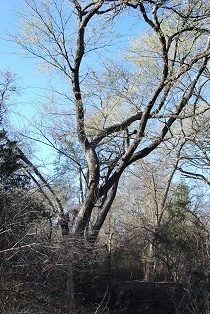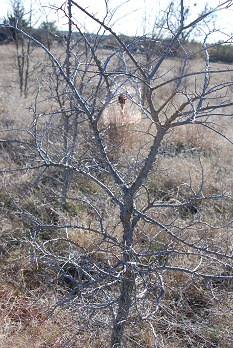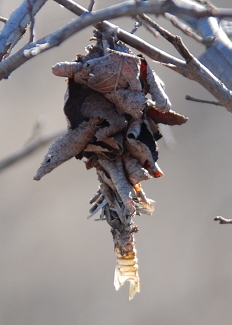Even in a drought year, trees put out buds–at this time of year, the elms and hackberries and the early oaks may flower, and some of the migrant birds enjoy a lofty “salad” of buds from them. Here’s one of our taller elms showing golden-green lace against the blue sky.

Early spring elm
This afternoon’s walk produced another mystery. I was walking past a group of young cedar elms that have sprung up in one meadow–we decided to leave some of them to form a small thicket–and noticed a sort of lump that seemed to be hanging from a twig:

What's that lump?
I highlighted around it in this image so you could see it more easily. I’ve walked past this little tree before and not noticed it–which is exactly what its maker had in mind.
Here’s a close-up:

Who made it?
It has the same shape, though it’s much larger than, the casing made by juniper bagworms. The leaves on the upper part are all cedar elm leaves, which suggests it was made before this tree lost its leaves…though there are plenty of leaves in the grass nearby.
I don’t know what made it, or what the adult form looks like…but I’ll be watching for more of these to find out. Anyone who knows, feel free to comment. (I may send this to one of the specialized listservs or sites to find out.)
Comment by Chuck — February 23, 2009 @ 7:21 am
I’ve occasionally seen this kind of bag while walking across my dad’s place in Parker County. This TAMU site lists elm among the species of trees that bagworms use: http://insects.tamu.edu/fieldguide/cimg247.html
So maybe your first impression is correct. The larger size may be a result of the bag being formed using bigger leaves.
Comment by elizabeth — February 23, 2009 @ 8:40 am
I’m wondering how many species of “bagworm” there are…this is larger not only because of the size of the leaves compared to those made of bits of juniper needles/scales, but longer top to bottom, and the bit of whatever-it-was sticking out the bottom is larger in diameter and also longer than I’ve ever seen with a juniper bagworm “bag.” Those are at most 1.5 – 2 inches in length, and if the pupa has matured, the bits of leftover sticking out the bottom are thinner and shorter. This was over 3 inches long, altogether. Maybe we have stunted juniper bagworms…or maybe there’s more than one kind.
I do love mysteries, though…
I think it’s time to call in the experts. I should go out and collect it this morning…except I have a bunch of chores in the house that Must Be Done Today. Thanks for the URL.
Comment by elizabeth — February 23, 2009 @ 9:44 am
Correction: my memory of the bag’s size was wrong; it’s about 2 1/4 inches long, just barely over the limit listed in that article (and maybe that’s the leftover pupal stuff sticking out the bottom.
I went out and collected it, snipping off the twig it was on, so I could measure it and dissect it. I’m pretty sure this must’ve been the male’s bag (the temptation to say mailbag is overwhelming, as you see) because of the evidence that something exited.
Comment by Susan Froebel — February 26, 2009 @ 2:48 pm
Bagworm was my my initial reaction, too. We had a juniper (a “fluffy” kind of juniper, rather than the local “cedar” juniper) on our front walk and harvesting bagworms and dropping them in a coffee can of kerosene was an annual activity. If Dad was feeling particularly fed up with them, he’d put the can on the sidewalk when we were done and throw a lit cigarette in it. This harvesting kept us from losing our juniper as many other homes did.
“Mailbag!” Sigh. 🙂